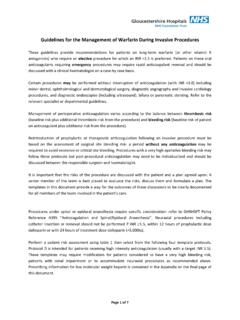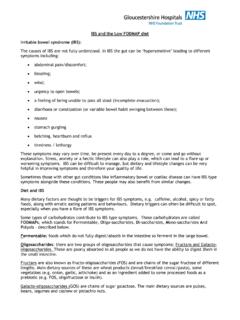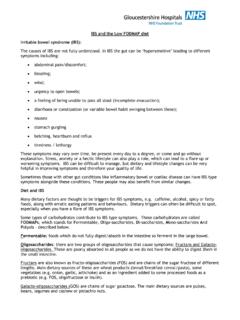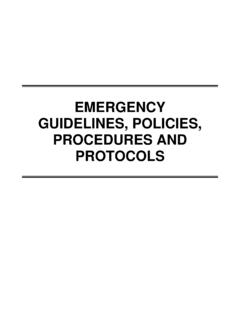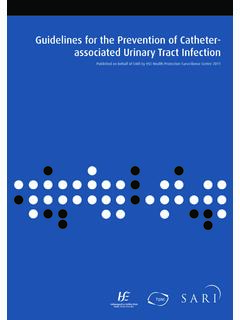Transcription of Intrapleural Fibrinolytics (tPA + DNase) for Pleural Infection
1 Page 1 of 5 Treatment Guideline Intrapleural Fibrinolytics (tPA + DNase) for Pleural Infection Summary Patients with Pleural Infection should be managed with antibiotics and drainage of the Pleural cavity If medical management fails or is not possible, referral for surgical management should be considered Intrapleural fibrinolytic treatment with alteplase (tPA) and dornase alfa (DNase) may be considered as an adjunct to medical management in selected patients at the discretion of the Respiratory Consultant This guideline details the rationale, indications, contraindications and protocol for administering Intrapleural fibrinolytic treatment Scope This guidance relates to adult inpatients with non-resolving Pleural Infection .
2 Such patients should be under the care of the Respiratory physicians. Decisions related to this treatment must be made by a Respiratory Consultant. Introduction Pleural Infection has a significant mortality of up to 20%. Standard medical management with antimicrobials and chest tube drainage fails in approximately 30% of patients. Such patients are often referred for thoracic surgery, but many patients are not suitable for surgery due to co-morbidities or frailty, and the surgery itself is not without morbidity and is associated with long hospital stays. Intrapleural fibrinolysis with a combination of alteplase (tPA) and dornase alfa (DNase) has been shown in a randomised controlled trial (MIST2) to reduce rate of referral for surgery and the duration of hospital stay for patients with Pleural Infection treated with antibiotics and chest drain insertion.
3 This combination treatment reduces length of stay by a mean of days and reduces referral for thoracic surgery by 77% (Rahman et al. 2011). It is currently unclear how the use of Intrapleural fibrinolytic therapy should be used in the context of thoracic surgery, however if a patient fails to improve after 24-48 hours of treatment with chest tube drainage and antimicrobials, Intrapleural tPA/DNase can be used at the discretion of a Respiratory Consultant. If used, it should be administered early in the disease course. Since MIST2, a further multinational observational series has been published, which aimed to evaluate the pragmatic real-life application of tPA/DNase treatment for Pleural Infection in a large cohort of unselected patients from centres in three countries.
4 Of the 107 patients treated, the majority ( ) were successfully managed without the need for surgical intervention (Piccolo et al. 2014). The MIST2 protocol involved the administration of Intrapleural medications separated by a minimum of two hours, however the concurrent instillation has been demonstrated to be safe and effective (Majid et al. 2016). Authors: Henry Steer & Oliver Bintcliffe Approved by Respiratory Unit Meeting: June 2018 Review date: June 2021 Page 2 of 5 Case reports have described Pleural bleeding in patients on full-dose anticoagulation or in those with end-stage renal disease treated with Intrapleural Fibrinolytics .
5 Such patients were not excluded from MIST2 however and no clear evidence exists that such factors should represent a complete contraindication to treatment. Anticoagulation, an uncorrected coagulopathy or severe renal or hepatic impairment may however increase the risks of Pleural bleeding and the risks and benefits of Intrapleural Fibrinolytics should be considered carefully alongside alternative management. Protocol Patients should be given information regarding this treatment and consent to its use. The specific risks that should be discussed are: (1) Intrapleural bleeding Haemorrhagic Pleural fluid is a common observation following administration but frank Intrapleural bleeding is rare (2%). Rarely, a blood transfusion may be necessary as a result.
6 (2) Discomfort/pain Normal saline ( NaCl) flushes cause pain in approximately 3% of patients. There appears to be a slightly higher risk of pain (5%) with tPA and DNase. This is likely to be mild and may require analgesia. The maximum course is twice daily administration of both agents for 3 days but the patient may not require the whole course if there is clinical resolution at an earlier stage. The frequency of the treatment may be reduced to once daily if agreed by the responsible Respiratory Consultant. Any alternative options, including surgery, should also be discussed in detail with the patient if appropriate. Contraindications and exclusion criteria - Use of Intrapleural Fibrinolytics would result in a delay to appropriate thoracic surgical intervention - Hypersensitivity to alteplase or dornase alfa and their excipients - Patients under 18 years of age - Active Pleural bleeding - Current coincidental stroke - Current major chest haemorrhage or trauma including intercostal artery injury - Major surgery in the previous 5 days - Previous pneumonectomy on the affected side - Pregnancy or breastfeeding Relative contraindications - Risk factors for a Pleural bleed (for example an uncorrectable coagulopathy)
7 - Severe hepatic or renal impairment - Patients on anticoagulation with warfarin or New Oral Anticoagulants (NOACs) Authors: Henry Steer & Oliver Bintcliffe Approved by Respiratory Unit Meeting: June 2018 Review date: June 2021 Page 3 of 5 Initiating Criteria Criteria Investigations/results Initial Management Radiological evidence of persistent infected effusion despite 24 hours of attempted drainage with an appropriately sited and patent drain and appropriate antibiotic therapy AND An inadequate or incomplete clinical response to appropriate antibiotic treatment Clinical evidence of Pleural Infection Macroscopically purulent Pleural fluid OR Pleural fluid positive for bacteria on Gram Stain or positive culture OR Pleural fluid with a pH < in a patient with
8 Clinical evidence of Infection OR clinical evidence of Infection with imaging indicating loculated empyema Regimen Drug name Dose (administered intrapleurally) Frequency Duration Dornase alfa 5mg in 30ml Normal saline 12 hourly Maximum of 3 days Alteplase 10mg in 30ml Normal saline Administration Intrapleural alteplase and dornase alfa should only be administered by doctors who have been trained in the administration of Intrapleural medications. Both medications must be available and administered in combination. Either medication in isolation is ineffective, or may be harmful. Equipment checklist Sterile gloves Chlorhexidine wipes Dressing pack Dornase alfa (5mg in 30ml of NaCl ) CLEARLY LABELLED FOR Intrapleural USE ONLY Alteplase (10mg in 30ml NaCl ) CLEARLY LABELLED FOR Intrapleural USE ONLY 1 x 30m NaCl flush 3 x 10ml NaCl flushes Procedure checklist Prior to the procedure Consultant respiratory physician approval obtained Patient consent obtained and procedure explained Ensure the patient has IV access Authors: Henry Steer & Oliver Bintcliffe Approved by Respiratory Unit Meeting: June 2018 Review date.
9 June 2021 Page 4 of 5 Procedure 1 Ensure all necessary equipment and drugs are obtained and prescribed on the patient s drug chart (see list above) 2 Confirm position and patency of the intercostal drain (complete with 3-way tap) with imaging and by flushing with 30mls NaCl; confirm there is no leakage around the tube 3 Ensure 3-way tap is off to the side port ( open from Pleural space through to underwater seal Figure 1) 4 Remove bung and clean the side port with a chlorhexidine wipe 5 Attach first 30ml syringe containing alteplase to side port.
10 Turn 3-way tap off to the underwater seal ( open from Pleural space to side port - Figure 2) and inject alteplase into the Pleural space 6 Turn 3-way tap off to the patient ( open from the side port through to underwater seal - Figure 3) 7 Attach 10ml syringe containing sodium chloride flush to the side port. Turn 3-way tap off to the underwater seal ( open from Pleural space to side port - Figure 2) and inject flush into the Pleural space. 8 Turn 3-way tap off to the patient ( open from the side port through to underwater seal - Figure 3) 9 Attach second 30ml syringe containing dornase alfa to side port. Turn 3-way tap off to the underwater seal ( open from Pleural space to side port - Figure 2) and inject dornase alfa into the Pleural space 10 Turn 3-way tap off to the patient ( open from the side port through to underwater seal - Figure 3) 11 Attach 10ml syringe containing sodium chloride flush.
